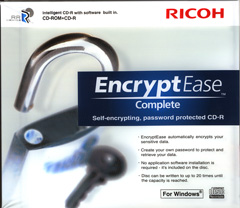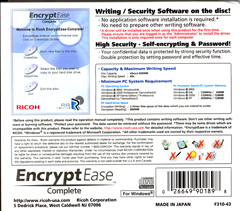Ricoh EncryptEase: CD-R Password Protection Made Easy
by Purav Sanghani on February 7, 2006 12:05 AM EST- Posted in
- Storage
Introduction
The life of the CD-R has hit its peak with many users moving on to higher capacity DVD writeable media for data storage and backup. Whether the use of writeable optical media is for data storage, media, or personal backup, many turn to 3rd party utilities to perform all of these operations.
Over the years as organizations, large and small, began migration of their paper data to electronic media, there came a need to provide protection to their sensitive information. Many used third party software from companies like EMC, Veritas (now merged with Symantec), and newer companies such as Idealstor and Novastor to encrypt and archive their most valuable data. However, all of these 3rd party vendors catered mainly to the enterprise level.
Only recently has desktop storage called on the need for data encryption with those same companies releasing software with both compression and encryption algorithms for the end user. Nowadays, we can all download a copy of WinZip or WinRAR, or purchase a copy of EMC's Retrospect backup software and see a fully functional suite that lets us shrink and protect our data without the enterprise level costs. But what is the next step?
Hybrid Optical Media
Hybrid media is an old idea from the stone age (late 90's), which showed us that a CD could contain more than one type of file system. For example, from information found on the Optical Storage Technology Association's website, the first type of hybrid media was able to store two types of file systems, a PC compatible session and a Mac compatible session. This type of media has been distributed for years by vendors who want to provide compatibility for their products to both types of users.
The second type of hybrid media came to us, which combined on-disc software with the ability to reach out to other sources such as a PC or the internet to retrieve the information that it required to operate.
The newest type of hybrid media is one where there is a stamped session at the beginning of the media and the rest of the disc is free, writeable disc space for additional sessions. This type of media is similar to the first type (where PC/Mac software coexists), in that the physical media is split into the different types of sessions.
How Is This Third Type of Hybrid Media Utilized?
Ricoh Co., LTD. announced their EncryptEase CD-R media in December 2005, which boasted 600MB disc space to store encrypted data with no additional software requirements except for the application located and run off of the disc. Ricoh takes the old hybrid CD idea and pushes it a step further by including a stamped first track occupied by their data encryption/compression software. Take a look at how it works.
The life of the CD-R has hit its peak with many users moving on to higher capacity DVD writeable media for data storage and backup. Whether the use of writeable optical media is for data storage, media, or personal backup, many turn to 3rd party utilities to perform all of these operations.
Over the years as organizations, large and small, began migration of their paper data to electronic media, there came a need to provide protection to their sensitive information. Many used third party software from companies like EMC, Veritas (now merged with Symantec), and newer companies such as Idealstor and Novastor to encrypt and archive their most valuable data. However, all of these 3rd party vendors catered mainly to the enterprise level.
Only recently has desktop storage called on the need for data encryption with those same companies releasing software with both compression and encryption algorithms for the end user. Nowadays, we can all download a copy of WinZip or WinRAR, or purchase a copy of EMC's Retrospect backup software and see a fully functional suite that lets us shrink and protect our data without the enterprise level costs. But what is the next step?
Hybrid Optical Media
Hybrid media is an old idea from the stone age (late 90's), which showed us that a CD could contain more than one type of file system. For example, from information found on the Optical Storage Technology Association's website, the first type of hybrid media was able to store two types of file systems, a PC compatible session and a Mac compatible session. This type of media has been distributed for years by vendors who want to provide compatibility for their products to both types of users.
The second type of hybrid media came to us, which combined on-disc software with the ability to reach out to other sources such as a PC or the internet to retrieve the information that it required to operate.
The newest type of hybrid media is one where there is a stamped session at the beginning of the media and the rest of the disc is free, writeable disc space for additional sessions. This type of media is similar to the first type (where PC/Mac software coexists), in that the physical media is split into the different types of sessions.
How Is This Third Type of Hybrid Media Utilized?
Ricoh Co., LTD. announced their EncryptEase CD-R media in December 2005, which boasted 600MB disc space to store encrypted data with no additional software requirements except for the application located and run off of the disc. Ricoh takes the old hybrid CD idea and pushes it a step further by including a stamped first track occupied by their data encryption/compression software. Take a look at how it works.
 |
 |
| Click to enlarge. | |










18 Comments
View All Comments
tygrus - Tuesday, February 7, 2006 - link
I can understand that hiding the data in another section of the CD makes it harder to extract, the system should not rely on this. Other tools could be used to copy or extract the raw data. It would have been better to have the software to use the CD to be self-suficient and require no driver to be installed. How long before zombe PC's are decrypting CD's ?Webmaster: Can you please add the title of the article/thread to the top of the page a link to open the thread in a new window (or inline frame). This would make it easier to reference and quote.
tygrus - Tuesday, February 7, 2006 - link
No edit ...spelling corrections ...
self-sufficient
zombie
chilled - Tuesday, February 7, 2006 - link
Why isn't it just possible to have the software write the data that is pre-recorded onto the disc at burn time, instead of in advance?Wouldn't this mean that any media could be used, instead of paying $5 per CDR....?
artifex - Tuesday, February 7, 2006 - link
Having a program ridealong on every disc is an unnecessary waste of space, once you've had the opportunity to install the driver once. Basically, this seems like an excuse to take BestCrypt or DriveCrypt type software to a per-disc fee structure. Only the software sounds much more limited. And it certainly locks you into Windows for data retrieval, later.Oh, and what do you do when you want to back up these encrypted disks? And how come you can't browse the data in these files transparently, but have to copy them to the hard drive?
Calin - Tuesday, February 7, 2006 - link
This is nothing different than having a file compressed with password. I wonder how well this system survives to a storage error... in a normal CD, only the "scratched" file is lost, in this way it might be the entire session is lost.Agree with the "per disk" fee, and it is certanly too expensive, as you could buy 10 normal CDs for the price of one of these
Wesley Fink - Tuesday, February 7, 2006 - link
EncryptEase is a good idea, but at a suggested retail of $6.99 for a 600MB CD-R disk and an actual selling price of more than $5 per CD-R it is probably too expensive to attract many home users. With the really cheap prices of CD-R blanks, CD-RW,DVD and DVD-RW blanks, more than $5 a disk for just 600MB of Data Storage, no matter how secure, seems very expensive for home users.If Ricoh could do this for DVD and have it work for RW media it might make some cost sense.
PrinceGaz - Tuesday, February 7, 2006 - link
$5 for one 600MB CD-R that has some burning/encryption software included on the disc, when instead you could buy about 25 normal CD-R discs for the same price. Oh, I can really see these special discs flying off the shelves. Not.Strange that the price of the discs was not mentioned in the article...
Googer - Tuesday, February 7, 2006 - link
How is this differant or any better than the securecord offerd by my Plextor Premieum?http://plextor.com/english/products/Premium.html">http://plextor.com/english/products/Premium.html